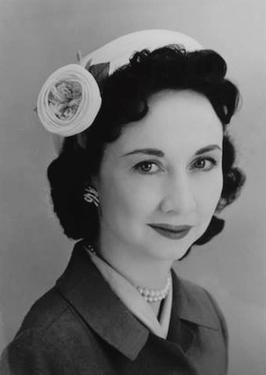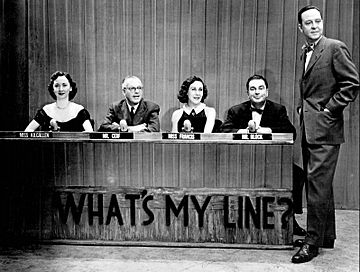Dorothy Kilgallen facts for kids
Quick facts for kids
Dorothy Kilgallen
|
|
|---|---|

Kilgallen ca. 1955
|
|
| Born |
Dorothy Mae Kilgallen
July 3, 1913 Chicago, Illinois, U.S.
|
| Died | November 8, 1965 (aged 52) New York City, U.S.
|
| Resting place | Gate of Heaven Cemetery |
| Education | Erasmus Hall High School |
| Alma mater | The College of New Rochelle |
| Occupation | Media personality, author, journalist, panelist |
| Spouse(s) |
Richard Kollmar
(m. 1940) |
| Children | 3 |
Dorothy Mae Kilgallen (born July 3, 1913 – died November 8, 1965) was a famous American writer, journalist, and TV show panelist. She studied at the College of New Rochelle for a short time. Then, just before her 18th birthday, she started working as a reporter for the New York Evening Journal.
In 1938, she began writing her own newspaper column called "The Voice of Broadway." This column became very popular and was printed in over 140 newspapers. Later, in 1950, she joined the TV game show What's My Line? as a regular panelist. She stayed on the show until she passed away.
Dorothy Kilgallen's columns often shared news and gossip about show business. But she also wrote about other important topics, like politics and organized crime. She wrote major articles for newspapers about the Sam Sheppard trial. Years later, she also covered events related to the John F. Kennedy assassination, including what Jack Ruby said in court.
Contents
Life and Career
Early Life and Becoming a Reporter
Dorothy Kilgallen was born in Chicago. Her father, James Lawrence Kilgallen, was also a newspaper reporter. Her mother was Mae Ahern. Dorothy was of Irish background and was Catholic. She had a younger sister named Eleanor.
Her family moved around the United States until 1920. That year, her father got a job as a traveling reporter based in New York City. The family then settled in Brooklyn, New York. Dorothy went to Erasmus Hall High School. After two semesters at The College of New Rochelle, she left college. She took a job as a reporter for the New York Evening Journal. This newspaper was owned by the same company that employed her father.
Racing Around the World
In 1936, Dorothy Kilgallen took part in an exciting race around the world. She competed against two other reporters from New York newspapers. They could only use transportation that was available to the public. Dorothy was the only woman in the race and she finished in second place!
She wrote a book about her adventure called Girl Around The World. This book later inspired the story for a 1937 movie called Fly-Away Baby. The main character in the movie was partly based on Dorothy Kilgallen.
"Voice of Broadway" Column
In November 1938, Dorothy started writing a daily column called "Voice of Broadway." It was for a newspaper called the New York Journal-American. She wrote this column until her death in 1965.
Her column mostly shared news and gossip about New York's entertainment world. But she also wrote about politics and organized crime. The column became very popular and was printed in 146 newspapers. Because of its success, Dorothy was able to move her parents and sister from Brooklyn to Manhattan. She lived with them there until she got married.
Radio Show Host
On April 6, 1940, Dorothy Kilgallen married Richard Kollmar. He was an actor and singer. They had three children: Richard, Jill, and Kerry. They stayed married until Dorothy's death.
Early in their marriage, both Dorothy and Richard started careers in radio. Dorothy had her own radio show called Voice of Broadway. It was broadcast on CBS during World War II. Richard starred in a popular crime drama radio show.
Starting in April 1945, Dorothy and Richard hosted a weekday radio talk show together. It was called Breakfast With Dorothy and Dick. They broadcast the show from their large apartment in New York City. The show was similar to Dorothy's newspaper column. It mixed entertainment news and gossip with more serious topics. They sometimes had baseball players as guests. The couple continued their show from home until 1963.
The Sam Sheppard Case
Dorothy Kilgallen covered the 1954 trial of Sam Sheppard. He was a doctor accused of his wife's death in Ohio.
The New York Journal-American newspaper printed a headline saying Dorothy was "astounded" by the guilty decision. She believed there were serious problems with the case against him. At the time, her strong criticism was controversial. One Cleveland newspaper even stopped printing her column because of it.
Years later, after the judge in the case had passed away, Dorothy shared something new. She claimed at an event that the judge had told her before the trial began that Sheppard was "guilty as hell."
A lawyer named F. Lee Bailey heard Dorothy's story. He was working to help Sam Sheppard. Bailey asked Dorothy for her help. She gave a statement that was used in a legal challenge to Sheppard's conviction. Another court worker also said the judge had believed Sheppard was guilty early on.
In July 1964, a federal judge agreed with the legal challenge. Sam Sheppard was released from prison. He later met Dorothy Kilgallen at a party. After Dorothy's death, Sheppard had another trial and was found not guilty.
Investigating the Kennedy Assassination
Dorothy Kilgallen was not convinced by the official report about President Kennedy's assassination. She also questioned the shooting of Lee Oswald by Jack Ruby. She wrote several newspaper articles about these events.
On February 23, 1964, she published an article about a talk she had with Jack Ruby. This conversation happened during a break in his murder trial. She also got a copy of Ruby's statements to the official investigation committee. She published these statements in August 1964 in several newspapers.
"What's My Line?" TV Show

Dorothy Kilgallen became a panelist on the American TV game show What's My Line?. She was on the very first show, which aired live on February 2, 1950. The show was broadcast from New York City on the CBS network. She appeared almost every Sunday evening for 15 years, until her death.
Later, the show started using videotape, which was a new invention. This allowed the panelists, including Dorothy, to take summer vacations. In 1965, they returned to live broadcasts. Dorothy appeared live for eight Sundays in a row. Her last live appearance was on November 7, the night before she passed away.
Death
On November 8, 1965, Dorothy Kilgallen was found deceased in her New York City home. Her death was unexpected.
Her funeral was held on November 11 in Manhattan. Many famous people attended, including John Charles Daly, Arlene Francis, Betty White, and Ed Sullivan. She was buried at the Gate of Heaven Cemetery in Hawthorne, New York.
Legacy
In 1960, Dorothy Kilgallen was one of the first 500 people to receive a star on the Hollywood Walk of Fame.
The What's My Line? TV show paid tribute to Dorothy Kilgallen on November 14, 1965. Another panelist, Kitty Carlisle, filled in for Dorothy during that episode. She said on camera that while she was in Dorothy's seat, "no one could ever possibly take her place."
Filmography
- Sinner Take All (1936) - played a reporter
- Fly-Away Baby (1937) - her book Girl Around the World inspired the story
- Pajama Party (1964) - had a small, uncredited appearance as herself
In Fiction
A character named Flo Kilgore, who is based on Dorothy Kilgallen, appears in novels by Max Allan Collins. In the book Ask Not (2013), this character helps investigate the JFK assassination.
See also
 In Spanish: Dorothy Kilgallen para niños
In Spanish: Dorothy Kilgallen para niños
- List of unsolved deaths


